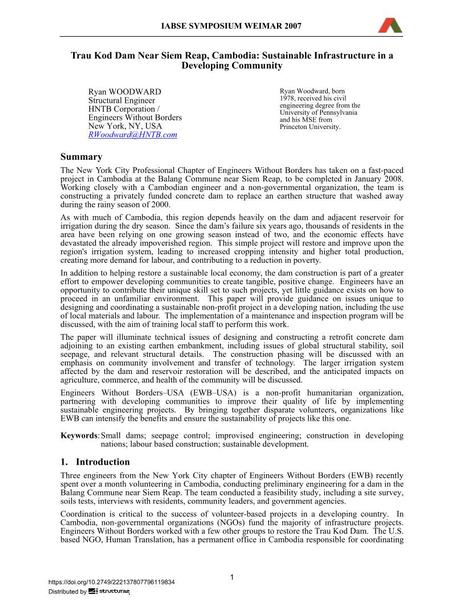Trau Kod Dam Near Siem Reap, Cambodia: Sustainable Infrastructure in a Developing Community

|
|
|||||||||||
Bibliographic Details
| Author(s): |
Ryan Woodward
|
||||
|---|---|---|---|---|---|
| Medium: | conference paper | ||||
| Language(s): | English | ||||
| Conference: | IABSE Symposium: Improving Infrastructure Worldwide, Weimar, Germany, 19-21 September 2007 | ||||
| Published in: | IABSE Symposium Weimar 2007 | ||||
|
|||||
| Page(s): | 98-99 | ||||
| Total no. of pages: | 8 | ||||
| Year: | 2007 | ||||
| DOI: | 10.2749/222137807796119834 | ||||
| Abstract: |
The New York City Professional Chapter of Engineers Without Borders has taken on a fast-paced project in Cambodia at the Balang Commune near Siem Reap, to be completed in January 2008. Working closely with a Cambodian engineer and a non-governmental organization, the team is constructing a privately funded concrete dam to replace an earthen structure that washed away during the rainy season of 2000. As with much of Cambodia, this region depends heavily on the dam and adjacent reservoir for irrigation during the dry season. Since the dam’s failure six years ago, thousands of residents in the area have been relying on one growing season instead of two, and the economic effects have devastated the already impoverished region. This simple project will restore and improve upon the region's irrigation system, leading to increased cropping intensity and higher total production, creating more demand for labour, and contributing to a reduction in poverty. In addition to helping restore a sustainable local economy, the dam construction is part of a greater effort to empower developing communities to create tangible, positive change. Engineers have an opportunity to contribute their unique skill set to such projects, yet little guidance exists on how to proceed in an unfamiliar environment. This paper will provide guidance on issues unique to designing and coordinating a sustainable non-profit project in a developing nation, including the use of local materials and labour. The implementation of a maintenance and inspection program will be discussed, with the aim of training local staff to perform this work. The paper will illuminate technical issues of designing and constructing a retrofit concrete dam adjoining to an existing earthen embankment, including issues of global structural stability, soil seepage, and relevant structural details. The construction phasing will be discussed with an emphasis on community involvement and transfer of technology. The larger irrigation system affected by the dam and reservoir restoration will be described, and the anticipated impacts on agriculture, commerce, and health of the community will be discussed. Engineers Without Borders–USA (EWB–USA) is a non-profit humanitarian organization, partnering with developing communities to improve their quality of life by implementing sustainable engineering projects. By bringing together disparate volunteers, organizations like EWB can intensify the benefits and ensure the sustainability of projects like this one. |
||||
| Keywords: |
small dams sustainable development seepage control improvised engineering construction in developing nations labour based construction
|
||||
